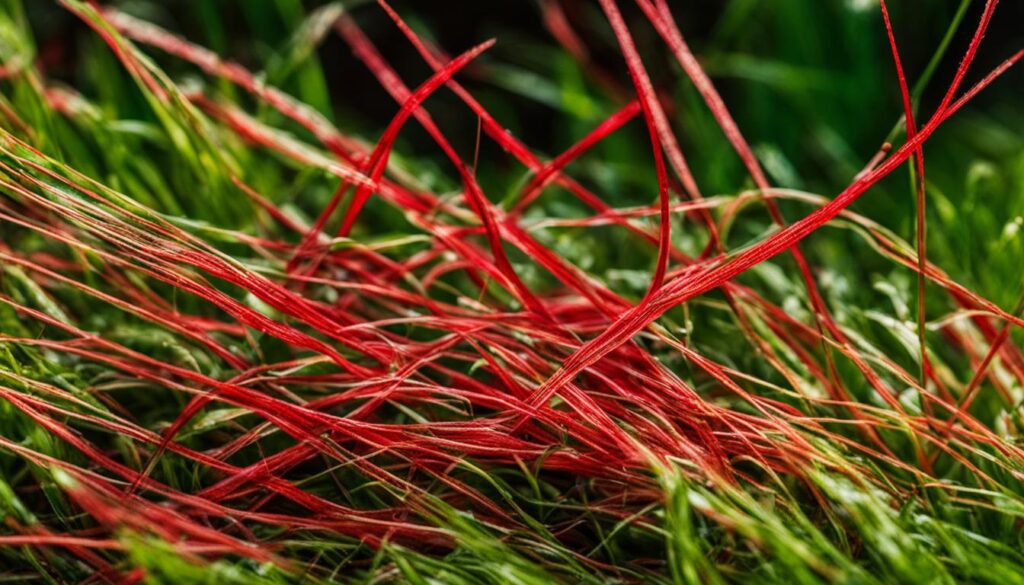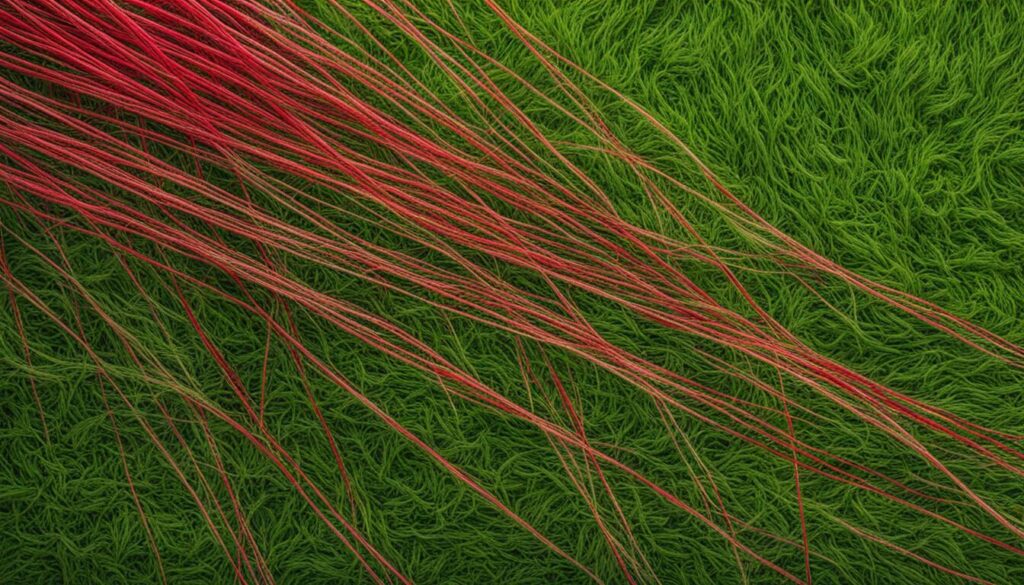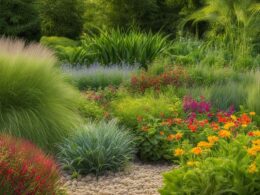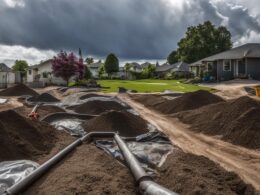If you’ve noticed pink or tan circular patches with threads extending from your lawn’s grass blades, you may be dealing with a common fungal disease known as red thread. This lawn disease, caused by the corticioid fungus Laetisaria fuciformis, thrives in cool temperatures, high humidity, and excessive moisture. Understanding the causes of red thread and implementing quick fixes is essential to restore your lawn’s health and prevent further damage.
Key Takeaways:
- Red thread is a fungal lawn disease caused by the corticioid fungus Laetisaria fuciformis.
- The disease appears as pink or tan circular patches on the lawn, with strands or threads extending from the grass blades.
- Causes of red thread include slow-growing and undernourished turfgrass, as well as environmental conditions that favor fungal growth.
- Proper identification is crucial to implementing the correct treatment methods for red thread.
- Treating red thread lawn disease involves a combination of cultural practices and chemical treatments.
Identifying Red Thread Lawn Disease
Red thread lawn disease is easily identifiable due to the appearance of pink or reddish patches on the grass, accompanied by thin grass blades and spiky threads. This condition is most commonly observed during the spring season but can also occur in the fall and winter. It is caused by the fungus Laetisaria fuciformis and tends to affect lawns composed of specific grass species. Proper identification of red thread is essential for implementing the appropriate treatment methods.
When diagnosing red thread, look for lawns with patches or areas displaying discolored grass ranging from pink to reddish hues. The presence of thin grass blades and spiky threads extending from the grass blades distinguishes it from other lawn diseases. Red thread is more likely to occur in lawns consisting of susceptible grass species such as bentgrass, bermudagrass, fescues, and perennial ryegrass.
Causes of Red Thread Lawn Disease
Red thread lawn disease is caused by a combination of environmental factors and the presence of the fungal pathogen. The disease thrives in mild temperatures, high humidity, and wet conditions, creating the perfect environment for the growth and spread of the fungus. If your turfgrass is undernourished and slow-growing, it becomes more susceptible to red thread. Certain grass species, such as bentgrass, bermudagrass, fescues, and perennial ryegrass, are particularly prone to this disease.
To prevent red thread in your lawn, it is crucial to maintain healthy soil and implement proper lawn care practices. Ensuring that your turfgrass is well-fed and receives the necessary nutrients will help it grow strong and resistant to diseases. Avoid overfertilization and overwatering, as excessive moisture creates favorable conditions for the development of red thread. Additionally, practicing good lawn maintenance techniques, such as regular mowing at the appropriate height, can help prevent the disease from taking hold.
By understanding the causes of red thread lawn disease and implementing preventive measures, you can reduce the risk of your lawn being affected. Taking proactive steps to maintain a healthy lawn will not only prevent the occurrence of red thread but also promote overall lawn health and vitality.
Treating Red Thread Lawn Disease
Treating red thread lawn disease involves a combination of cultural practices and chemical treatments. To effectively manage and control red thread, it is essential to implement proper lawn care practices.
Cultural practices: Regular mowing at the correct height helps prevent the spread of the disease and promotes healthier grass growth. Fertilization with a balanced lawn fertilizer provides the necessary nutrients to strengthen the turfgrass and make it more resistant to diseases like red thread. Proper watering is crucial as well. Water deeply and infrequently to encourage deep root growth and prevent excessive moisture, which can promote fungal growth.
Chemical treatments: Fungicides containing chlorothalonil or thiophanate-methyl can effectively control red thread. These fungicides should be applied according to the manufacturer’s instructions. It is important to follow the recommended dosage and frequency to ensure successful treatment. Apply the fungicide evenly over the affected areas, as well as the surrounding healthy grass.
Additionally, aerating compacted soil can help improve air circulation and reduce moisture, creating a less favorable environment for the growth of the red thread fungus. Improving drainage in areas prone to standing water can also aid in managing and preventing the disease.
Maintaining a Healthy Lawn After Treatment
After treating red thread lawn disease, it is essential to maintain a healthy lawn to prevent reoccurrence. Following proper maintenance practices will help ensure your lawn stays vibrant and resilient. Here are some key steps to take:
- Mow at the correct height: Maintain your grass at the recommended height for your specific grass type. This will help promote healthy growth and prevent the spread of disease.
- Keep blades sharp: Regularly sharpen your mower blades to ensure clean cuts. Dull blades can stress the grass and make it more susceptible to disease.
- Regular fertilization: Apply a balanced fertilizer according to the needs of your grass species. This will provide the necessary nutrients for healthy growth and recovery.
- Water deeply but infrequently: Water your lawn deeply once or twice a week rather than frequent shallow watering. This encourages deep root growth and reduces the risk of disease.
- Address dead grass and weeds promptly: Remove any dead or dying grass as well as weeds as soon as you notice them. This will prevent them from competing with healthy grass and provide optimal growing conditions.
- Overseed with new grass seed: If there are any thin or bare spots in your lawn after treating red thread, overseed those areas with new grass seed. This will help fill in gaps and promote a lush, even lawn.
- Fortify drainage in wetter areas: Enhance drainage in areas prone to excessive moisture by aerating the soil and, if necessary, installing drainage systems. This will prevent waterlogging and reduce the risk of disease.
By following these steps, you can maintain a healthy lawn that is resilient against red thread and other diseases. Take the time to give your lawn the care it needs, and you’ll be rewarded with a beautiful, thriving outdoor space.
Conclusion
In conclusion, red thread lawn disease is a common issue that can be effectively managed with proper identification and treatment. By understanding the causes, symptoms, and treatment methods, homeowners can take proactive steps to prevent and control red thread in their lawns. It is important to address red thread promptly to prevent further damage to the lawn.
Maintaining a healthy lawn through regular care practices is crucial for preventing the disease from reoccurring. Proper mowing techniques, regular fertilization, and appropriate watering can help keep the lawn in excellent condition. Additionally, addressing any dead grass or weed growth promptly, overseeding with new grass seed, and fortifying drainage in wetter areas can contribute to maintaining a healthy lawn after treatment.
With the right knowledge and ongoing maintenance, homeowners can enjoy a lush, green lawn free from red thread. By following the recommended steps and implementing proper lawn care practices, you can ensure the longevity and vibrancy of your lawn. Say goodbye to red thread and hello to a beautiful, healthy outdoor space.
Explore Advanced Lawn Care Techniques for a Beautiful Yard
After successfully treating red thread lawn disease, you can take your lawn care routine to the next level to ensure a lush, healthy yard. By implementing advanced techniques and practices, you can further enhance the beauty and resilience of your lawn.
Proper Lawn Aeration for Optimal Growth
Aeration is a crucial step in maintaining a healthy lawn. By creating small holes in the soil, you promote better air circulation, nutrient absorption, and water penetration. This process helps alleviate compaction and promotes deeper root growth, resulting in a stronger and more vibrant lawn. Consider renting an aerator or hiring a professional to perform this task effectively.
Overseeding for a Fuller Lawn
Overseeding is the process of spreading grass seed across the existing lawn to fill in thin or bare areas. This technique helps thicken the turf, improve density, and reduce weed infestation. Choose a high-quality grass seed blend suitable for your region and grass type. Follow the recommended seeding rates and spread the seeds evenly. Water the area regularly to promote germination and establishment.
Smart Watering Techniques to Conserve Resources
Efficient watering practices not only conserve water but also promote a healthy lawn. Consider installing a smart irrigation system with moisture sensors and programmable timers. Adjust watering schedules based on weather conditions, time of day, and grass species. Water deeply and infrequently to encourage deep root growth and drought tolerance. Avoid overwatering, as it can lead to shallow root systems and increased disease susceptibility.
Regular Soil Testing for Optimal Nutrition
Healthy soil is the foundation of a thriving lawn. Periodically test your soil to assess its nutritional composition and pH levels. This information will help determine the appropriate fertilization needs of your lawn. Follow the recommendations from the soil test results and apply a high-quality, balanced fertilizer to provide essential nutrients for optimum growth.
Meticulous Weed Control for a Pristine Lawn
Even with proper lawn care, weeds can still emerge and compete with your grass for nutrients and space. Implement a proactive approach to weed control by regularly inspecting your lawn for weed growth. Remove weeds manually or use appropriate herbicides to target specific weed types without harming the grass. Follow the product instructions carefully, ensuring safe and effective weed management.
Maintaining a Lush Green Lawn: Expert Tips
Now that you have treated your lawn for red thread disease, it’s essential to maintain its health and prevent future outbreaks. Follow these expert tips to keep your lawn looking lush and green:
1. Regular Mowing: Continue mowing your lawn at the recommended height for your grass type. This helps promote healthy growth and prevents the spread of fungal diseases.
2. Proper Watering: Water deeply but infrequently. This encourages deep root growth and helps the grass withstand stress. Avoid overwatering, as it can create a favorable environment for fungal diseases like red thread.
3. Fertilization and Weed Control: Apply a balanced fertilizer according to the specific needs of your grass type. Regular fertilization helps maintain the health and vigor of the lawn. Additionally, promptly address any weed growth to prevent competition for nutrients.
4. Soil Aeration: Aerate your lawn to relieve soil compaction and improve air circulation. This allows the roots to absorb oxygen and nutrients more effectively, contributing to a healthier lawn.
By following these maintenance practices, you can enjoy a beautiful and resilient lawn that is less susceptible to red thread disease and other common lawn issues.
How Does Treatment for Dollar Spot in Lawns Compare to Treatment for Red Thread?
When it comes to prevention and care tips for dollar spot in lawns versus treatment for red thread, the approaches differ. For dollar spot, frequent mowing and proper watering can help prevent the disease, while for red thread, improving soil fertility and reducing thatch are recommended prevention and care tips.
FAQ
What is red thread lawn disease?
Red thread lawn disease is a fungal lawn disease caused by the corticioid fungus Laetisaria fuciformis. It appears as pink or tan circular patches on the lawn, with strands or threads extending from the grass blades.
How can I identify red thread lawn disease?
Red thread lawn disease can be identified by the presence of pink or reddish patches on the grass, along with thin grass blades and spiky threads. It is most commonly seen in the spring but can also occur in the fall and winter.
What are the causes of red thread lawn disease?
Red thread lawn disease is caused by a combination of environmental factors and the presence of the fungal pathogen. It thrives in mild temperatures, high humidity, and wet conditions. Undernourished and slow-growing turfgrass is more susceptible to red thread.
How can I treat red thread lawn disease?
Treating red thread lawn disease involves a combination of cultural practices and chemical treatments. Proper lawn care practices, such as regular mowing at the correct height, fertilization, and watering, can help prevent and reduce the severity of the disease. Fungicides containing chlorothalonil or thiophanate-methyl can be used to effectively control red thread.
How can I maintain a healthy lawn after treating red thread lawn disease?
After treating red thread lawn disease, it is essential to maintain a healthy lawn to prevent reoccurrence. Proper mowing techniques, regular fertilization, watering deeply but infrequently, and addressing any dead grass or weed growth promptly can help keep the lawn in excellent condition.
What is the key takeaway about red thread in lawn?
Red thread lawn disease is a common problem that can be effectively managed with proper identification and treatment. By understanding the causes, symptoms, and treatment methods, homeowners can take proactive steps to prevent and control red thread in their lawns.









